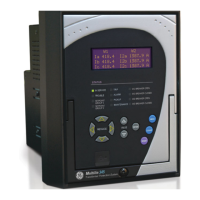
Do you have a question about the GE 345 and is the answer not in the manual?
Detailed description of the 345 relay's capabilities and benefits.
Information on how to specify a 345 relay using order codes.
Technical specifications and operating parameters of the 345 relay.
Details on password protection for master reset, settings, and control.
Overcurrent, sensitive ground, and differential protection element specifications.
Specifications for phase, ground, and sensitive ground current inputs.
Details on transient and event recorders, buffer sizes, and data storage.
Logic elements, breaker failure, ambient temperature specifications.
Specifications for contact inputs, including thresholds and recognition time.
Specifications for high range, low range, and all ranges power supply options.
Serial, Ethernet (Copper/Fiber), and USB communication specifications.
EMC, environmental, and safety test standards and levels applied.
Dimensions and weight of the 345 relay unit.
Operating and storage temperature, humidity, altitude, and ingress protection.
Describes physical installation, dimensions, and module withdrawal/insertion.
Covers wiring diagrams, terminal identification, CT connections, and control power.
Details serial, IRIG-B, and other communication interface connections.
Overview of the relay's front panel controls, display, and LEDs.
Self-test errors, flash messages, and target message display.
Installing, connecting, and configuring the relay using EnerVista SR3 software.
Working with setpoints, files, and upgrading relay firmware.
Overview of advanced EnerVista SR3 features like Flexcurve and waveform capture.
Using the "Quick Setup" utility for programming transformer parameters and elements.
List of setpoints programmable via the "Quick Setup" menu.
Overview of the minimal maintenance requirements for the 345 relay.
Recommended maintenance tasks while the relay is operational.
Recommended maintenance tasks when the relay is powered down.